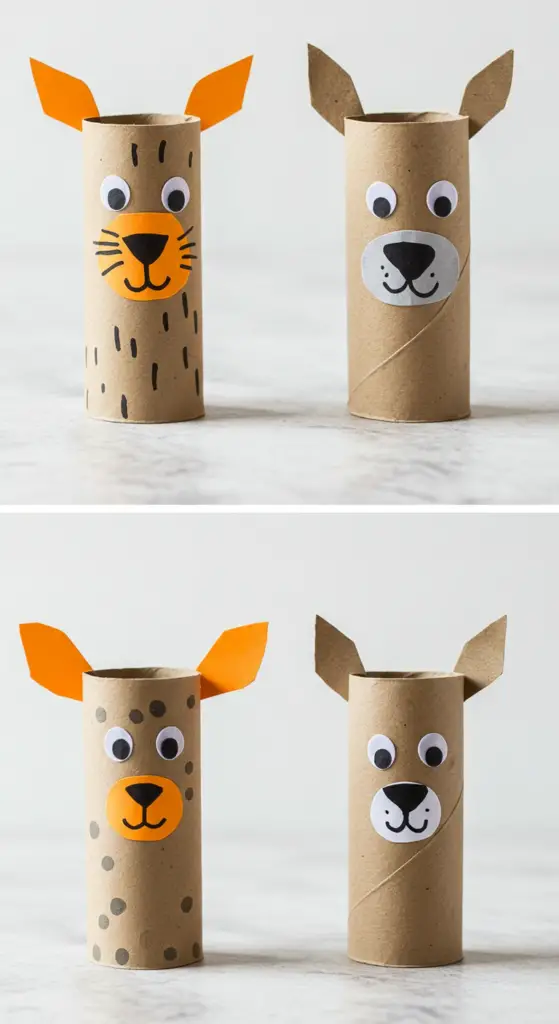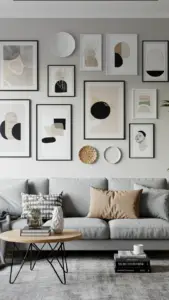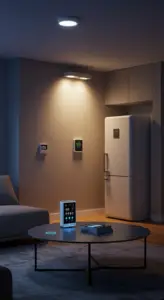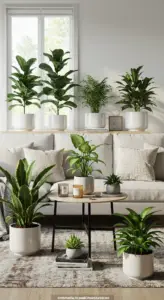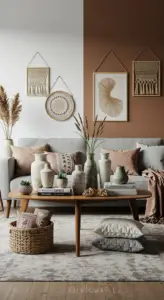1. Fun and Colorful DIY Tie-Dye T-Shirts for Kids

Fun and Colorful DIY Tie-Dye T-Shirts for Kids
Creating DIY tie-dye t-shirts for kids is a fantastic way to unleash creativity while making vibrant, personalized clothing. This trendy craft not only engages children but also results in unique fashion pieces they’ll love to wear.
Materials You’ll Need
- White cotton t-shirts
- Fabric dye (choose bright, kid-friendly colors)
- Rubber bands or string
- Plastic squeeze bottles
- Plastic gloves
- Plastic table cover or newspaper
Step-by-Step Guide
- Preparation: Lay down a plastic cover to protect your workspace.
- Design Your Pattern: Twist, fold, or spiral the shirt and secure it with rubber bands. Popular designs include the classic spiral and sunburst.
- Mix the Dye: Prepare your fabric dye according to package instructions.
- Apply the Dye: Using squeeze bottles, apply dye to different sections of the shirt. Encourage kids to experiment with color combinations!
- Set the Dye: Allow the dye to sit for 6-8 hours or overnight for optimal results.
- Rinse and Dry: Rinse the shirt in cold water until the water runs clear, then wash separately to set the colors.
Expert Tips and Tricks
- Tip 1: Always wear gloves to avoid dye stains on hands.
- Tip 2: Test colors on a scrap piece of fabric to see the final result.
- Tip 3: Avoid common mistakes like over-saturating the fabric, which can lead to muddy colors.
By following these expert guidelines, you can create fun and colorful DIY tie-dye t-shirts that kids will cherish. Remember, the key to successful tie-dyeing is creativity and patience—let the kids take the lead!
2. Create Whimsical Nature-Inspired Leaf Prints with Paint
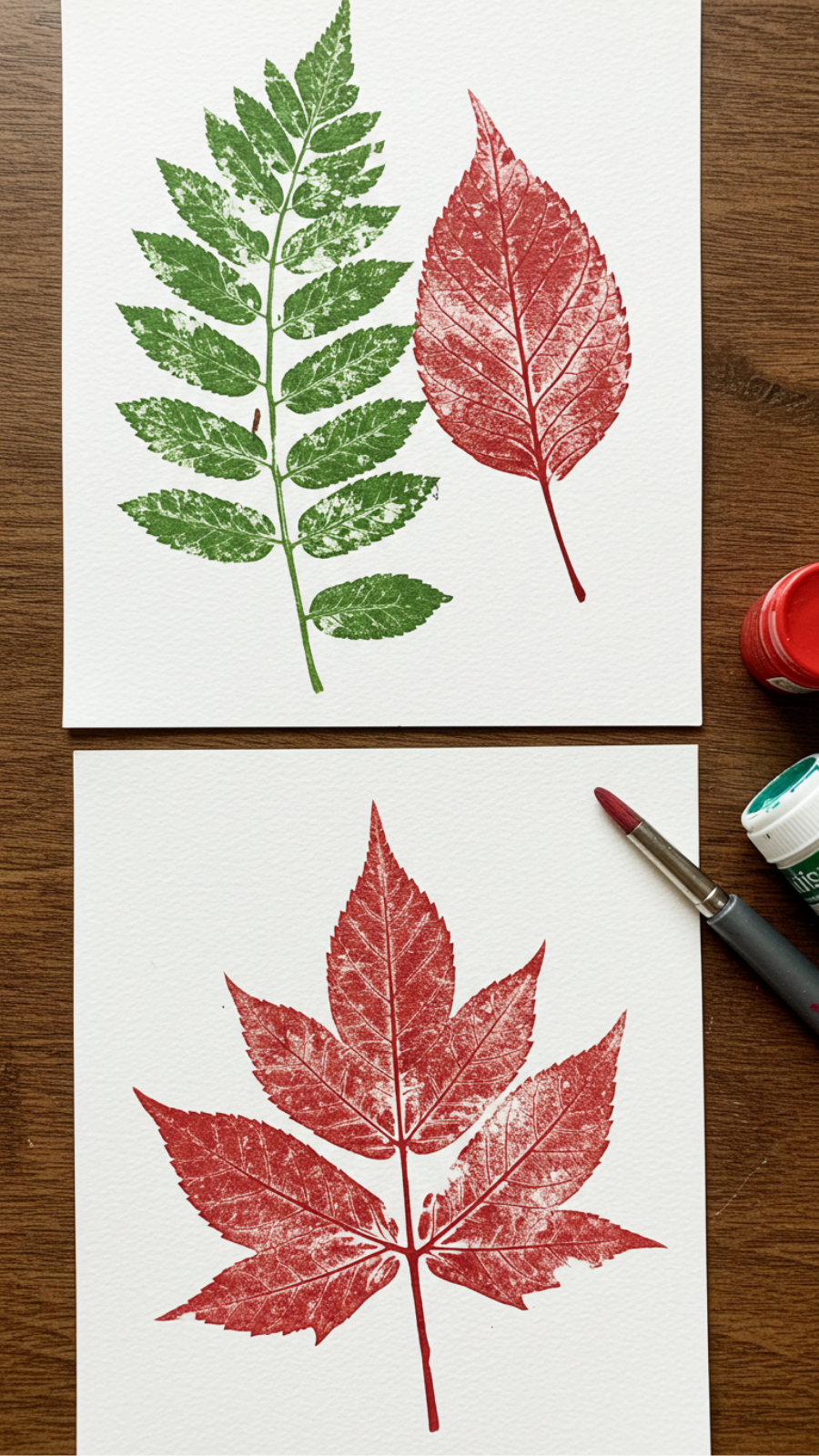
Create Whimsical Nature-Inspired Leaf Prints with Paint
Transform your outdoor treasures into stunning art pieces with nature-inspired leaf prints. This DIY craft is not only a delightful way to connect with nature, but it also taps into current trends favoring sustainable and eco-friendly art. Whether you’re a seasoned crafter or a beginner, follow these expert tips to create vibrant leaf prints that capture the beauty of the great outdoors.
Materials Needed
- Fresh leaves (various shapes and sizes)
- Acrylic or fabric paint
- Paintbrushes or rollers
- Paper or canvas
- Cardboard or a flat surface for printing
Step-by-Step Guide
- Collect Leaves: Choose a variety of leaves from your garden or local park. Look for unique shapes to add visual interest.
- Prepare Your Workspace: Lay down newspaper or a drop cloth to protect your surfaces.
- Apply Paint: Use a paintbrush or roller to apply an even layer of paint on the leaf’s underside.
- Print: Press the painted side of the leaf firmly onto your paper or canvas. Gently lift to reveal your print.
- Dry and Display: Allow your artwork to dry completely before displaying it in your home.
Expert Tips and Tricks
For the best results, consider these expert tips:
- Experiment with color blending for a more dynamic print.
- Use different surfaces, such as fabric or wood, to create unique textures.
- Preserve your prints with a clear sealant for longevity.
Avoid Common Mistakes
To ensure a successful project, keep these common pitfalls in mind:
- Don’t use overly dry leaves, as they may break during printing.
- Be cautious with paint application to avoid smudging.
- Avoid using too much paint; a thin layer works best.
Creating whimsical leaf prints is a fun way to celebrate nature. With these simple steps and expert advice, you can produce eye-catching art that reflects your love for the outdoors. Happy crafting!
3. Adorable DIY Friendship Bracelets Using Macramé Techniques
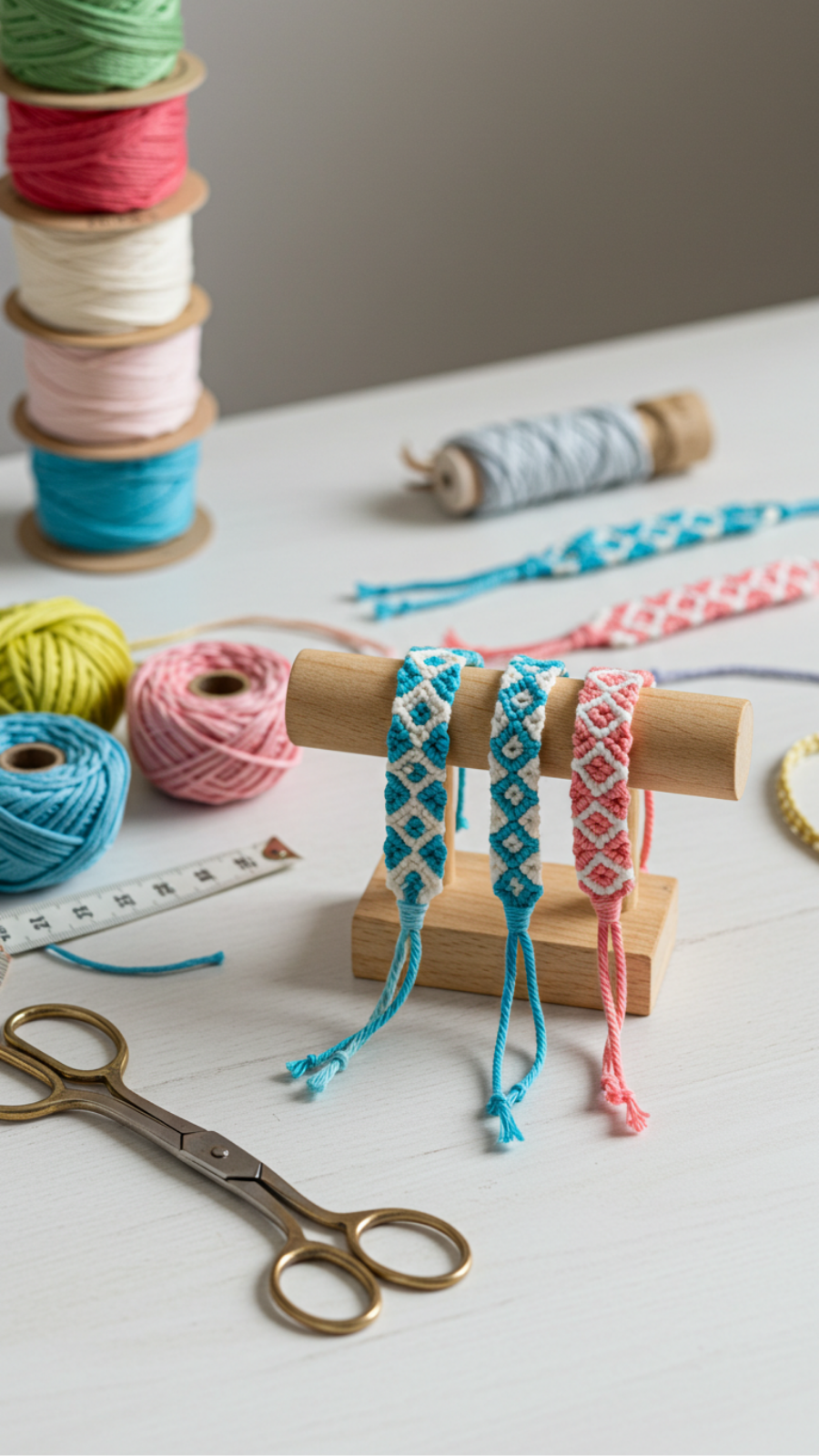
Adorable DIY Friendship Bracelets Using Macramé Techniques
Creating adorable DIY friendship bracelets using macramé techniques is a fun and meaningful way to express your creativity and strengthen bonds with friends. This trend has surged in popularity, offering a personalized touch to friendship gifts. Let’s dive into expert-level advice to craft stunning bracelets that showcase your style.
Materials You’ll Need
- Macramé cord (choose vibrant colors)
- Scissors
- Tape or clipboard (for securing your work)
- Measuring tape
Step-by-Step Guide
- Measure and Cut: Cut three strands of macramé cord, each about 50 inches long.
- Secure Your Cord: Attach the cords to a clipboard or tape them to a flat surface.
- Start Knotting: Use the square knot technique for a classic look. Make sure to pull your knots tight for durability.
- Add Patterns: Experiment with different knots like the half hitch for unique designs.
- Finishing Touch: Once you reach your desired length, tie off the ends and trim excess cord.
Expert Tips and Common Mistakes
To elevate your macramé bracelet game, consider these expert tips:
- Choose high-quality cord to ensure longevity.
- Maintain consistent tension while knotting for a professional finish.
- Avoid overcomplicating your design; simplicity often stands out.
Common mistakes include uneven knotting and inadequate securing of the cords, which can lead to a messy finish.
Conclusion
By incorporating macramé techniques into your DIY friendship bracelets, you can create beautiful, personalized pieces that reflect your unique style. Embrace the current trend and have fun making these charming accessories for yourself and your friends!
4. Upcycled Toilet Paper Roll Animals: Crafting with Recyclables
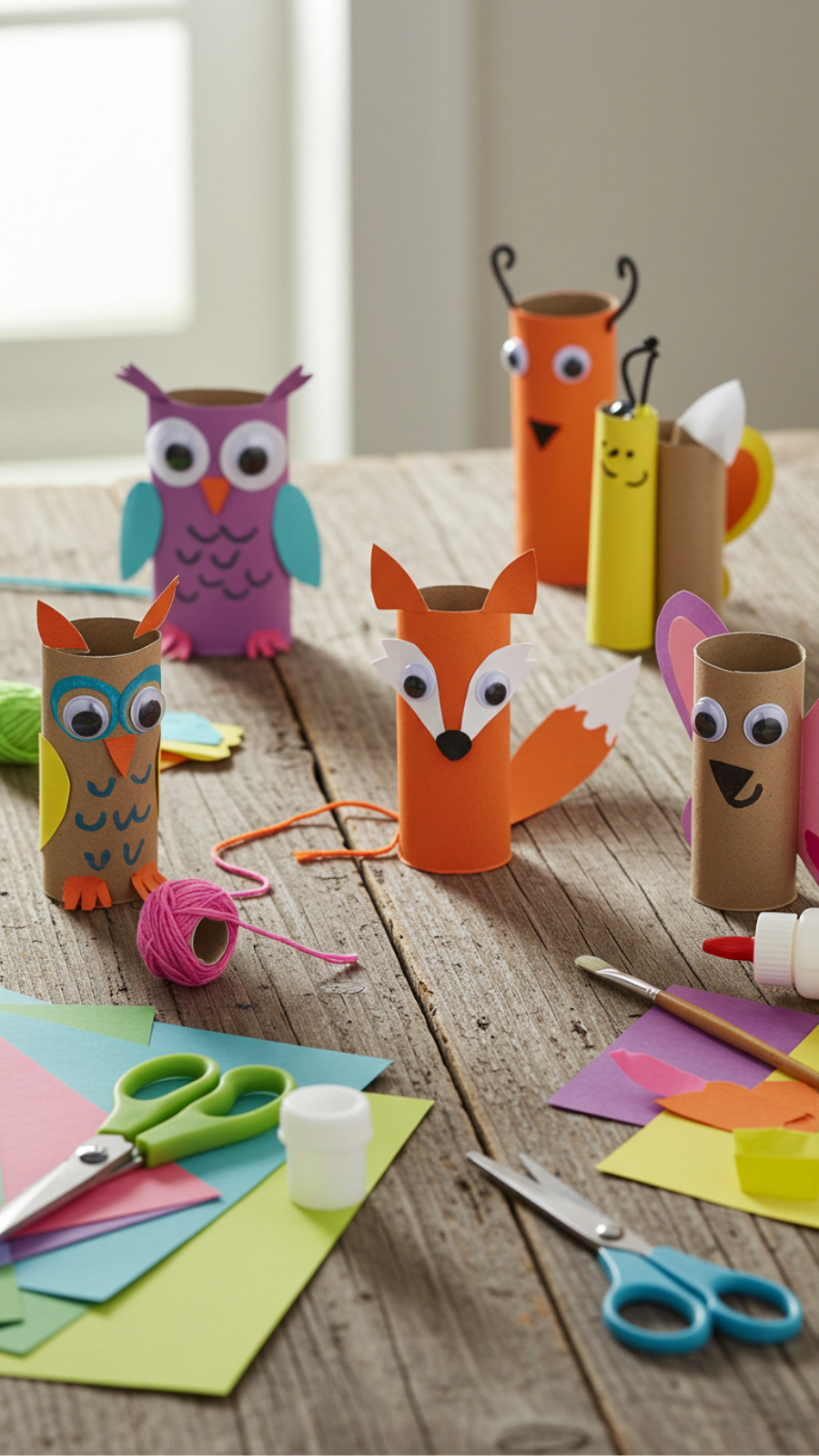
Upcycled Toilet Paper Roll Animals: Crafting with Recyclables
Transforming used toilet paper rolls into delightful animal crafts is a fun and eco-friendly way to engage creativity. Not only does this DIY project promote sustainability, but it also allows for imaginative play, especially for children. Here’s a guide on how to create charming upcycled toilet paper roll animals.
Materials Needed
- Toilet paper rolls
- Scissors
- Paint or markers
- Glue
- Googly eyes
- Craft paper or felt for details
Step-by-Step Guidance
- Choose Your Animal: Decide what animal you want to create. Popular choices include owls, bunnies, and turtles.
- Cut and Shape: Use scissors to cut the roll to the desired height. For example, for a bunny, create ears by cutting two small strips from the top.
- Decorate: Paint or color your animal. Use craft paper for additional features like wings or tails.
- Add Eyes: Glue on googly eyes or draw them for a personal touch.
- Allow to Dry: Let the craft dry completely before showcasing your creation.
Expert Tips and Common Mistakes
To enhance your crafting experience, consider these tips:
- Use a variety of materials like yarn or buttons for added texture.
- Plan your design before cutting to avoid mistakes.
- Engage children by allowing them to select colors and patterns.
Avoid common pitfalls, such as overloading the roll with paint or using too much glue, which can lead to messiness. Instead, focus on layering materials for depth without overwhelming the base.
Current Trends in DIY
Upcycling and sustainability are at the forefront of DIY trends. By creating upcycled toilet paper roll animals, you contribute to a greener planet while fostering creativity. This craft not only entertains but also teaches the importance of recycling and resourcefulness.
Now, gather your materials and start crafting! Upcycled toilet paper roll animals are not just a creative outlet; they’re a step toward a more sustainable lifestyle.
5. Interactive DIY Story Stones: Spark Imagination in Kids
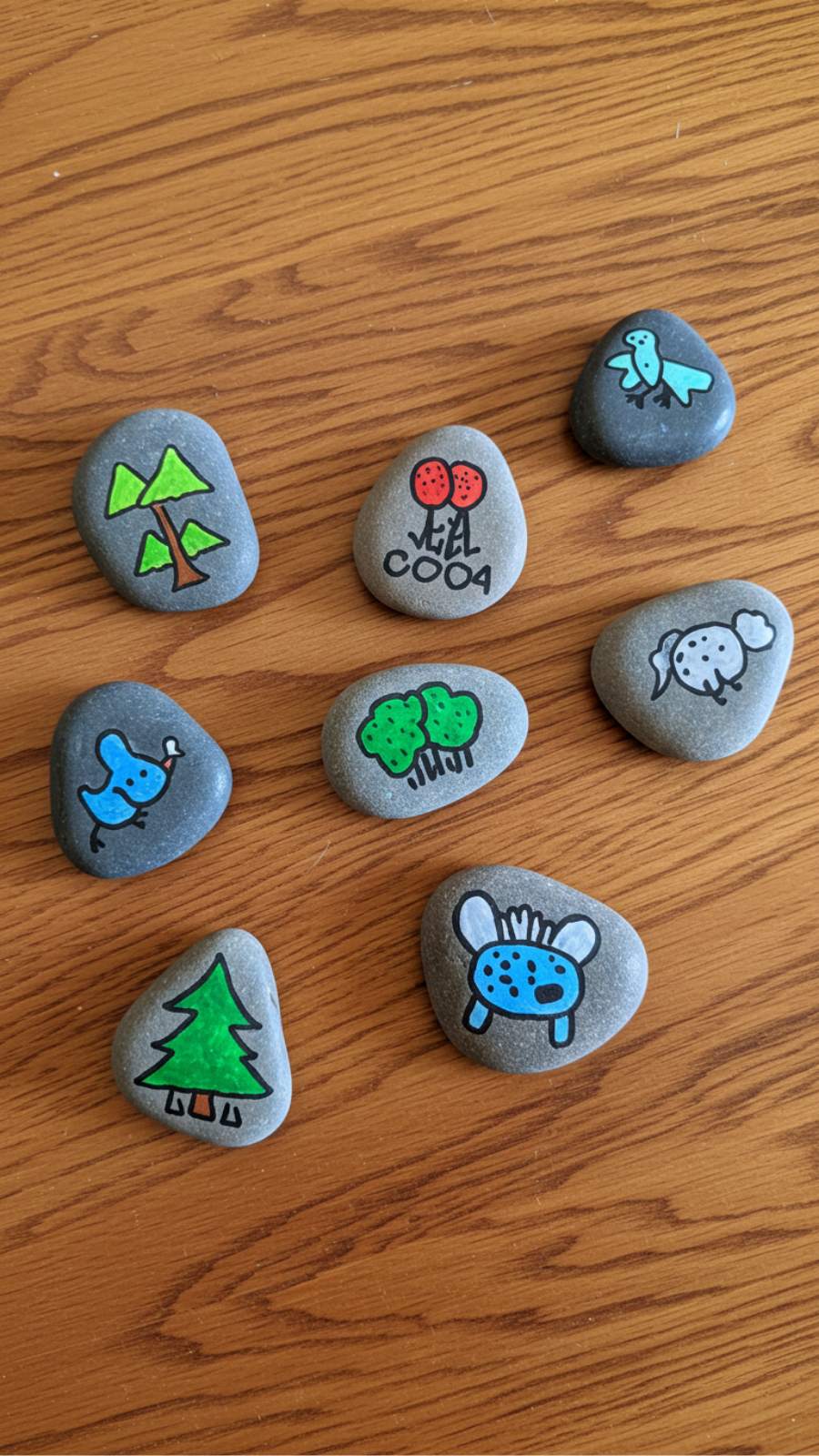
Interactive DIY Story Stones: Spark Imagination in Kids
Interactive DIY story stones are a fantastic way to inspire creativity and storytelling in children. These simple, yet engaging crafts can be customized to suit any theme, making them a popular choice among parents and educators alike.
What You’ll Need
- Smooth, flat stones
- Acrylic paints or permanent markers
- Sealer (optional)
- Paintbrushes
Step-by-Step Guide
- Gather Your Materials: Collect smooth stones from your garden or local park. Ensure they are clean and dry.
- Design Your Stones: Using acrylic paints or markers, draw images that represent various story elements, such as animals, characters, or objects.
- Seal Your Artwork: Once the paint is dry, apply a clear sealant to protect your designs, especially if children will be playing with them frequently.
- Storytelling Time: Encourage kids to use the stones to create their own stories. They can pick a few stones and weave a narrative based on the images.
Expert Tips and Tricks
- Incorporate seasonal themes to keep the stones relevant and engaging.
- Use natural materials like twigs or leaves to create a storytelling scene.
Common Mistakes to Avoid
- Choosing stones that are too rough; smooth stones work best for painting.
- Not allowing sufficient drying time between layers of paint.
By creating interactive DIY story stones, you can ignite your child’s imagination and encourage them to express their creativity. This hands-on project not only provides fun but also enhances narrative skills and critical thinking.
6. Charming DIY Painted Flower Pots for Spring Gardening Fun
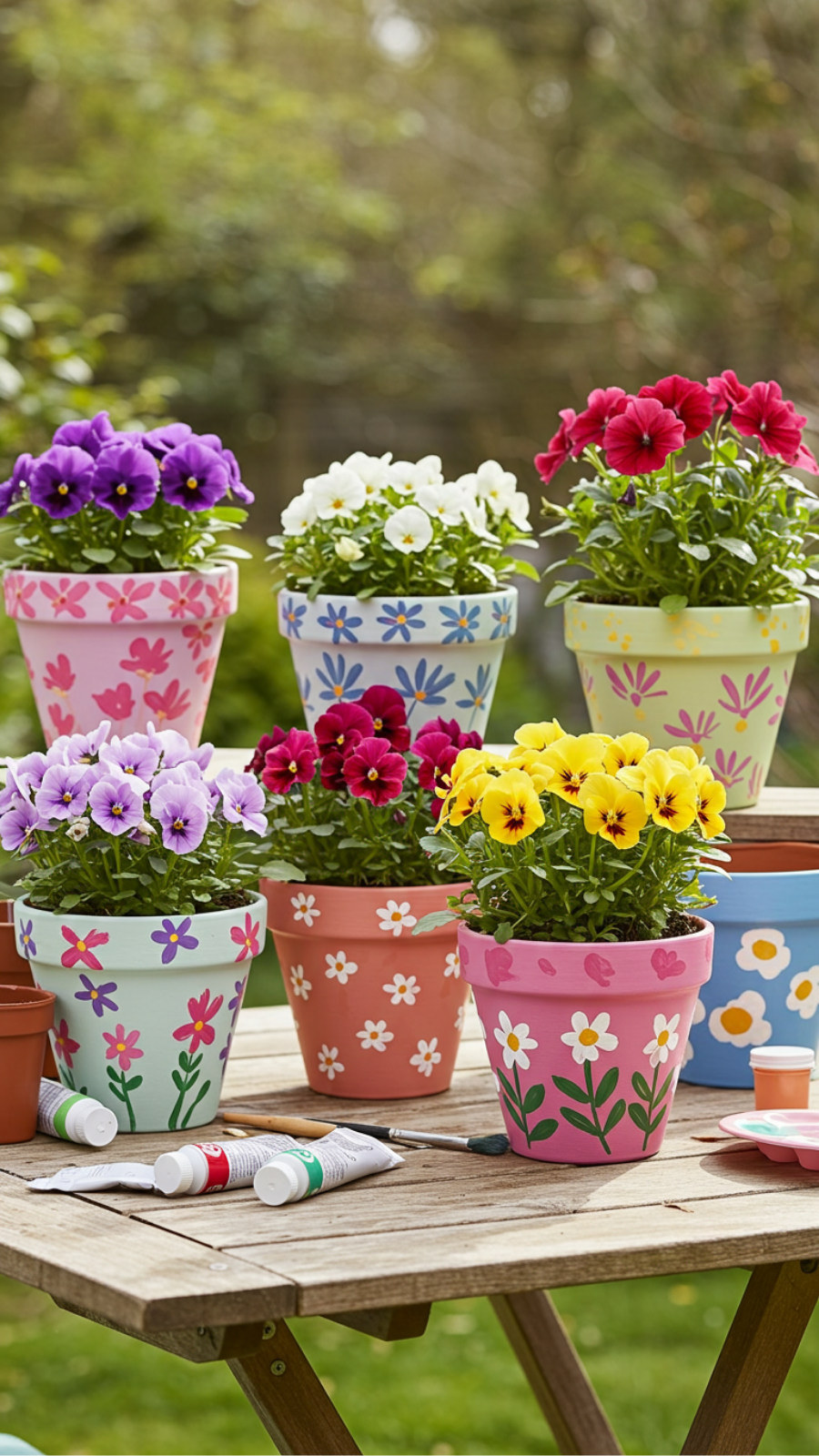
Charming DIY Painted Flower Pots for Spring Gardening Fun
Spring is the perfect time to breathe new life into your garden, and what better way to do that than with charming DIY painted flower pots? Not only do these colorful containers enhance your outdoor space, but they also provide a fun and creative outlet. In this guide, we’ll explore expert-level techniques and current trends to help you craft beautiful flower pots that will make your garden truly stand out.
Materials You’ll Need
- Terracotta pots
- Acrylic paint (weather-resistant recommended)
- Paintbrushes (various sizes)
- Sealer (optional, for durability)
- Stencils or painter’s tape (for design)
Step-by-Step Guide
- Prep Your Pots: Clean the terracotta pots thoroughly to remove dust and dirt. Allow them to dry completely.
- Design Planning: Sketch your design ideas on paper. Popular trends include geometric patterns, floral motifs, and personalized messages.
- Painting: Start with a base coat of acrylic paint. Once dry, use your brushes or stencils to add details. Layering colors creates depth.
- Sealing: If desired, apply a clear sealer to protect your designs from the elements.
Expert Tips and Common Mistakes to Avoid
To achieve the best results, consider these expert tips:
- Use painter’s tape for clean lines and precise edges.
- Don’t rush the drying process between layers; this ensures a professional finish.
- Avoid using indoor paint, as it may not withstand outdoor conditions.
By following these steps, you can create stunning painted flower pots that reflect your personal style while enhancing your spring gardening experience. Enjoy the process and let your creativity bloom!
7. Make Your Own Glittery Slime: A Sensory Craft Experience

Make Your Own Glittery Slime: A Sensory Craft Experience
Creating your own glittery slime is not only a fun DIY project but also a captivating sensory experience! This craft has surged in popularity among both children and adults as a creative outlet that engages the senses and encourages imaginative play.
Materials Needed
- 1 cup of white school glue
- 1 cup of warm water
- 1 teaspoon of baking soda
- 1 tablespoon of contact lens solution
- Glitter (your choice of color)
- Food coloring (optional)
Step-by-Step Guidance
- Mix the Base: In a bowl, combine the glue and warm water, stirring until well blended.
- Add the Baking Soda: Stir in the baking soda to enhance the slime’s texture.
- Incorporate Glitter: Add your desired amount of glitter and food coloring, mixing until evenly distributed.
- Activate the Slime: Slowly add the contact lens solution, stirring constantly until the mixture begins to pull away from the sides of the bowl.
- Knead the Slime: Once it’s cool enough to handle, knead the slime with your hands until it reaches a consistent texture.
Expert Tips and Tricks
To ensure your glittery slime is a hit:
- Use fine glitter for a smoother feel and more sparkle.
- Experiment with different colors and types of glitter to stay on-trend.
- Store your slime in an airtight container to extend its lifespan.
Avoid Common Mistakes
Many DIYers struggle with slime consistency. Avoid the following:
- Adding too much contact solution; it can make the slime rubbery.
- Not kneading enough; proper kneading improves texture.
With these tips, you can create your own glittery slime that not only sparkles but also provides a delightful sensory experience. Happy crafting!
8. Simple DIY Felt Puppets: Engaging Storytelling Tools
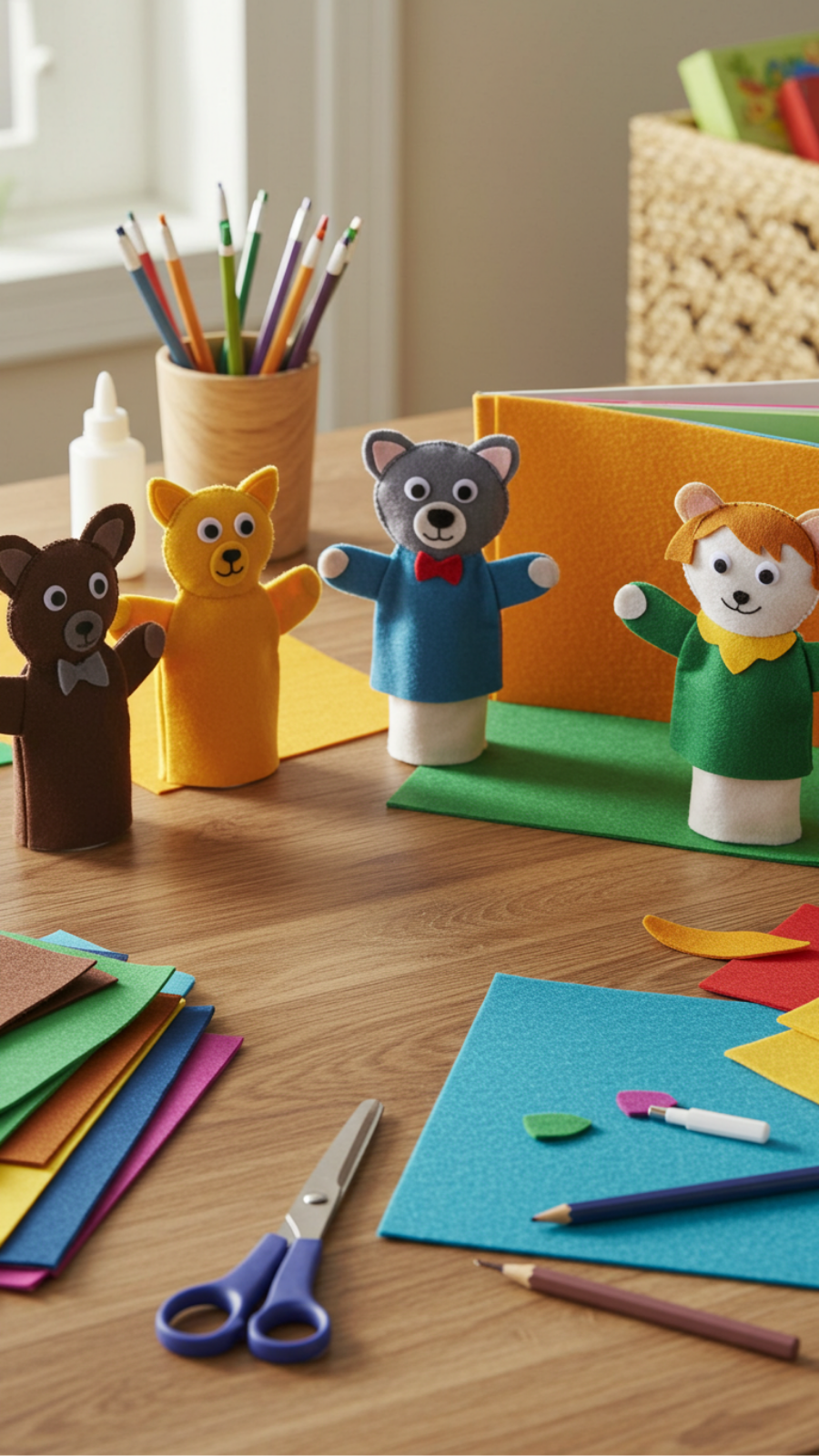
Simple DIY Felt Puppets: Engaging Storytelling Tools
Creating simple DIY felt puppets is an excellent way to foster creativity and storytelling skills in children and adults alike. These versatile puppets not only serve as engaging storytelling tools but also provide a fantastic opportunity to bond with family and friends. Let’s dive into the process of making your own felt puppets!
Materials Needed
- Colorful felt sheets
- Scissors
- Hot glue gun or fabric glue
- Markers or fabric paint
- Popsicle sticks (optional for hand puppets)
Step-by-Step Guide
- Design Your Puppet: Sketch a simple character. Choose a theme like animals, fairy tales, or superheroes.
- Cut the Felt: Cut out your puppet shapes from the felt. Use different colors for added detail, like eyes and accessories.
- Assemble the Pieces: Use a hot glue gun to attach the pieces. Ensure everything is secure and allow it to dry completely.
- Add Personal Touches: Use markers or fabric paint to draw facial features and other details.
- Engage in Storytelling: Use your puppets to tell stories, encouraging imaginative play.
Expert Tips and Tricks
- Experiment with textures by mixing felt with other materials like sequins or buttons.
- Keep your puppet sizes consistent for easy handling during performances.
Avoid Common Mistakes
- Don’t rush the drying process; ensure glue is fully set before use.
- Be mindful of sharp scissors; supervise younger children during the cutting phase.
By following these simple steps, you can create delightful DIY felt puppets that enhance storytelling experiences. With the current trend of interactive crafts, these puppets provide an engaging way to spark creativity and connection. Happy crafting!
9. Crafting Colorful Paper Mache Piñatas for Celebrations

Crafting Colorful Paper Mache Piñatas for Celebrations
Creating colorful paper mache piñatas is a delightful and engaging way to celebrate special occasions. These handcrafted decorations not only add flair to your festivities but also serve as a fun activity for participants of all ages. Follow our expert-level guide to craft your own piñata and make your next celebration unforgettable.
Materials Needed
- Balloon or cardboard base
- Paper mache paste (flour and water mix or store-bought)
- Colored tissue paper
- Paintbrush
- Scissors
- String for hanging
Step-by-Step Guide
- Prepare the Base: Inflate a balloon or create a small box shape using cardboard.
- Apply Paper Mache: Dip strips of newspaper into the paste and layer them over your base, allowing each layer to dry before adding more. Aim for at least 3-4 layers for durability.
- Decorate: Once dry, paint your piñata or cover it with colorful tissue paper. Use a glue stick for a seamless finish.
- Fill and Seal: Cut a small hole to fill your piñata with candies and toys, then seal it with more paper mache.
- Hang and Enjoy: Attach a string for hanging and get ready for the fun!
Expert Tips and Common Mistakes to Avoid
- Tip: Use vibrant colors and patterns to make your piñata visually striking.
- Avoid: Skipping the drying time between layers, as this can weaken the structure.
With these best practices, you’ll create a stunning, festive paper mache piñata that will be the highlight of your celebration. Embrace the current DIY trends by involving guests in the crafting process, turning it into a memorable experience. Happy crafting!
10. Kid-Friendly DIY Beaded Keychains: Fashion Meets Function

Kid-Friendly DIY Beaded Keychains: Fashion Meets Function
Creating kid-friendly DIY beaded keychains is an engaging craft that combines creativity, functionality, and current trends in DIY and creative crafts. These colorful accessories not only allow children to express their personal style but also serve practical purposes, such as keeping keys organized or adding charm to backpacks.
Materials Needed
- Assorted beads (wooden, acrylic, or glass)
- Elastic cord or keychain rings
- Scissors
- Optional: Alphabet beads for personalization
Step-by-Step Guidance
- Design Your Keychain: Begin by laying out your beads in a pattern. Encourage your child to mix colors and shapes for a unique look.
- String the Beads: Cut a piece of elastic cord about 10 inches long. Start threading the beads onto the cord, leaving enough space at each end to tie knots.
- Secure the Keychain: Once all beads are in place, tie a sturdy knot to secure them. If using a keychain ring, attach the beaded strand to it before tying off.
Expert Tips and Tricks
- Choose larger beads for younger kids to prevent choking hazards.
- Incorporate trendy elements like tassels or charms for added flair.
- Use a bead mat to keep beads from rolling away during crafting.
Common Mistakes to Avoid
When making beaded keychains, avoid overloading the cord with beads as this can lead to breakage. Additionally, ensure knots are tight enough to withstand daily use.
Best Practices
Encourage creativity by allowing kids to design their keychains without strict guidelines. This fosters a sense of ownership and pride in their creations. Plus, creating these functional accessories can be a fantastic bonding activity.
With these simple steps and tips, your kids can craft stylish, personalized keychains that reflect their individuality while enhancing their organizational skills. Dive into this fun project and watch their creativity shine!
11. Create a Cozy DIY Painted Rock Garden: Outdoor Decor Ideas
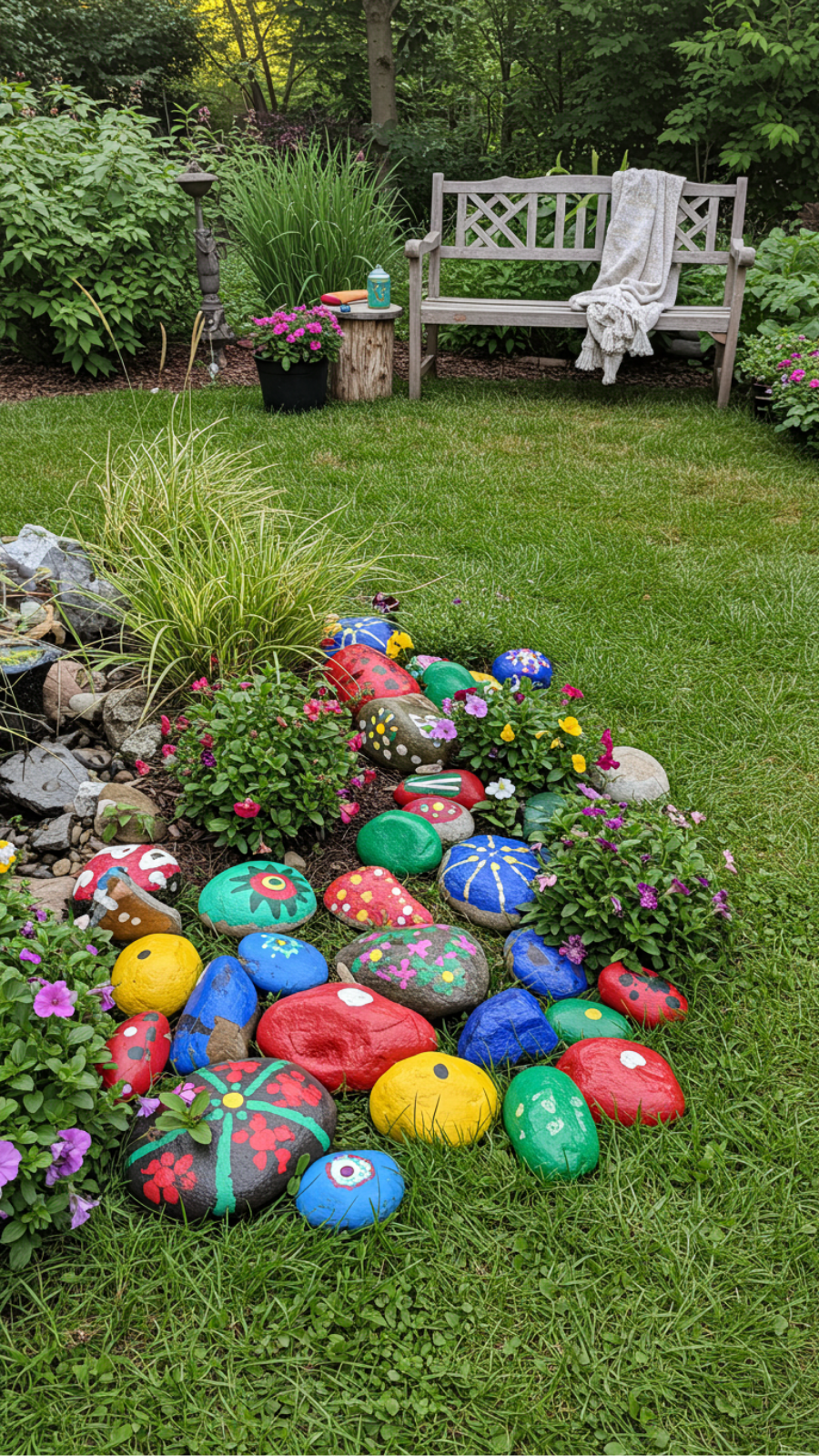
Create a Cozy DIY Painted Rock Garden: Outdoor Decor Ideas
Transform your outdoor space into a whimsical haven with a DIY painted rock garden. This creative craft not only adds personality to your landscape but also provides a fun and relaxing outdoor activity. Here’s how to get started.
Materials Needed
- Flat, smooth rocks
- Acrylic paints
- Paintbrushes (various sizes)
- Sealant spray
- Palette and water for mixing
Step-by-Step Guidance
- Choose Your Rocks: Look for a variety of sizes and shapes. Natural stones work best for a rustic feel.
- Clean and Dry: Wash your rocks with soap and water to remove dirt. Allow them to dry completely.
- Design Your Art: Sketch your designs lightly in pencil before painting. Popular themes include flowers, animals, and inspirational quotes.
- Paint Away: Use acrylic paints to bring your designs to life. Consider using multiple layers for vibrant colors.
- Seal Your Masterpieces: Once dry, spray with a clear sealant to protect your rocks from the elements.
Expert Tips and Tricks
To ensure a successful project, avoid common mistakes such as:
- Skipping the cleaning step; dirt can prevent paint adherence.
- Using water-based paints, which may wash away in rain.
- Neglecting to seal your rocks, leaving them vulnerable to fading.
Current Trends
Incorporate trending elements like geometric patterns or mandala designs for a modern twist. Also, consider adding your painted rocks to flower beds, pathways, or even as unique garden markers.
With these tips and a dash of creativity, your DIY painted rock garden will not only enhance your outdoor decor but also serve as a delightful conversation starter.
12. Easy DIY Candle Making with Natural Ingredients for Kids

Easy DIY Candle Making with Natural Ingredients for Kids
Creating homemade candles is a delightful and educational activity for kids. Not only does it spark creativity, but it also introduces children to the world of natural ingredients and DIY crafts. In this guide, we’ll explore easy methods for DIY candle making using safe, natural materials that are kid-friendly.
Materials Needed
- Natural wax (beeswax or soy wax)
- Essential oils for fragrance (lavender, citrus, etc.)
- Candle wicks
- Heat-resistant containers (glass jars or silicone molds)
- Double boiler or microwave-safe bowl
- Coloring agents (optional, like natural dyes)
Step-by-Step Guide
- Melt the Wax: In a double boiler, slowly melt your natural wax until it reaches about 170°F.
- Add Fragrance: Once melted, mix in essential oils. A good rule of thumb is 1 ounce of oil per pound of wax.
- Color Your Wax: If desired, add natural coloring agents for a fun twist.
- Prepare the Containers: Secure the wick in the center of your container using a small amount of melted wax.
- Pour the Wax: Carefully pour the melted wax into the containers and let it cool completely.
- Trim the Wick: Once set, trim the wick to about 1/4 inch above the wax surface.
Expert Tips and Tricks
- Safety First: Always supervise children when handling hot materials.
- Experiment: Encourage kids to mix different scents and colors.
- Common Mistakes: Avoid pouring wax too hot, as it can crack the container.
By following these best practices for DIY candle making, you’ll not only create beautiful candles but also foster creativity in your children. Happy crafting!
Frequently Asked Questions
How do I tie-dye a t-shirt with my kids?
Tie-dyeing t-shirts with kids is a fun and colorful activity. Start by gathering 100% cotton t-shirts, fabric dye, rubber bands, and gloves. Help your kids twist and bind the fabric with rubber bands, then let them apply the dye in their chosen colors. After letting the dye set, rinse the shirts to reveal vibrant patterns!
Why are nature-inspired crafts beneficial for kids?
Nature-inspired crafts, like leaf printing, foster creativity and appreciation for the environment. They encourage kids to explore outdoors, enhancing their observational skills while developing fine motor skills through painting and printing activities. These crafts also help them connect with nature, promoting environmental awareness from a young age.
What materials do I need to make friendship bracelets with macramé?
To create friendship bracelets using macramé techniques, you’ll need colorful embroidery threads or yarn, scissors, and tape or a clipboard to hold your work in place. Choose multiple colors for a vibrant design, and consider using varying thicknesses of thread to add texture and interest to your creations!
How can I help my child if they struggle with upcycling toilet paper roll animals?
If your child struggles with crafting upcycled toilet paper roll animals, offer step-by-step guidance by demonstrating each stage. Encourage creativity by suggesting different animal designs and features. Remember, the goal is to have fun—there’s no right or wrong way to create, so celebrate their unique creations!
What are story stones and how can they enhance my child’s storytelling skills?
Story stones are painted or decorated stones that feature images or symbols to inspire storytelling. They enhance your child’s imagination by providing visual prompts for creative narratives. Encourage your child to arrange the stones in a sequence and create a story based on the images, fostering both language skills and creativity!

